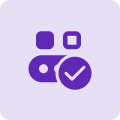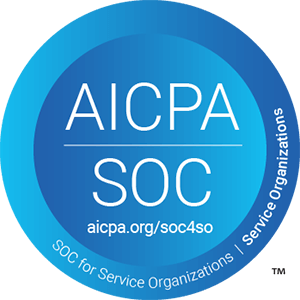“The user interface is a bit slow.”
“Definitely not a tool for OKR beginners.”
If these are some of the complaints you have with Workboard, you’re not alone. Many Workboard users have faced the same issues. And that’s one of the prominent reasons why they start searching for Workboard alternatives.
However, finding the right Workboard alternative can become a challenging task as more service providers enter the competitive market. To help you overcome this challenge, we listed four Workboard alternatives that will likely end your search for the best OKR software.
Let’s dive in.
Top 4 Workboard Alternatives
Here are the top 4 workboard alternatives that can help you implement your OKR strategy successfully.
1. Peoplebox.ai
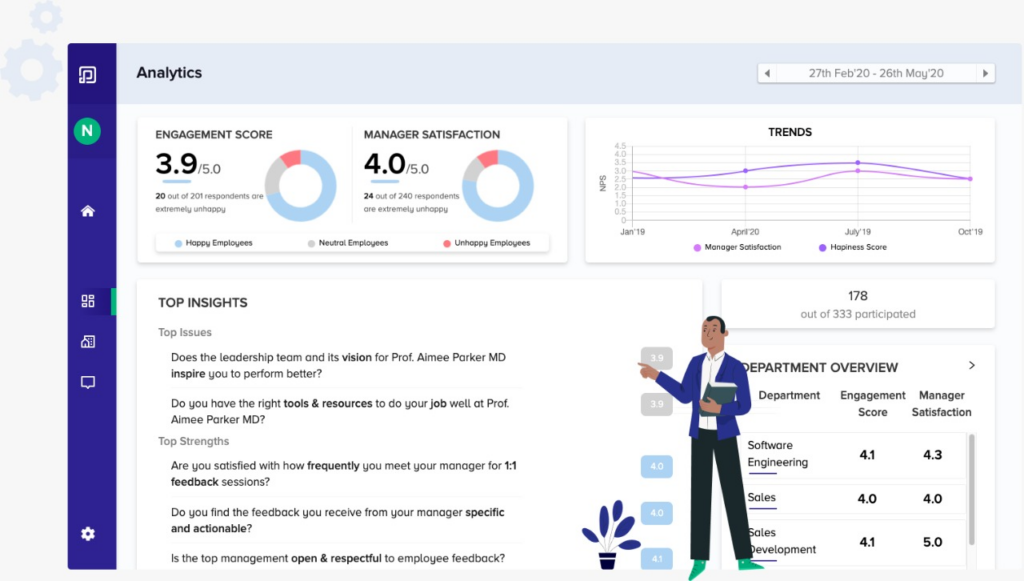
Peoplebox.ai, an OKR-focused strategy execution platform, is known for its ability to help its users build outcome-driven cultures and execute fast as they scale. The software provider assists you to create OKRs that help you execute your strategies and reach the desired goals. What’s more, you can also set OKRs from scratch. You can even track the progress of all the tasks in your OKRs with the help of their single-view dashboard. On top of that, Peoplebox helps you align all the objectives with the company goals and execute them faster.
Nova Benefits Case Study: How Nova Benefits drives exceptional business results with OKRs
Cometchat Case Study: Cometchat fosters a transparent work culture with performance reviews and OKR
Notable Features of Peoplebox.ai
Great UI: Peoplebox.ai’s platform is simple and straightforward to navigate, making it quick and effortless to establish goals and key results.
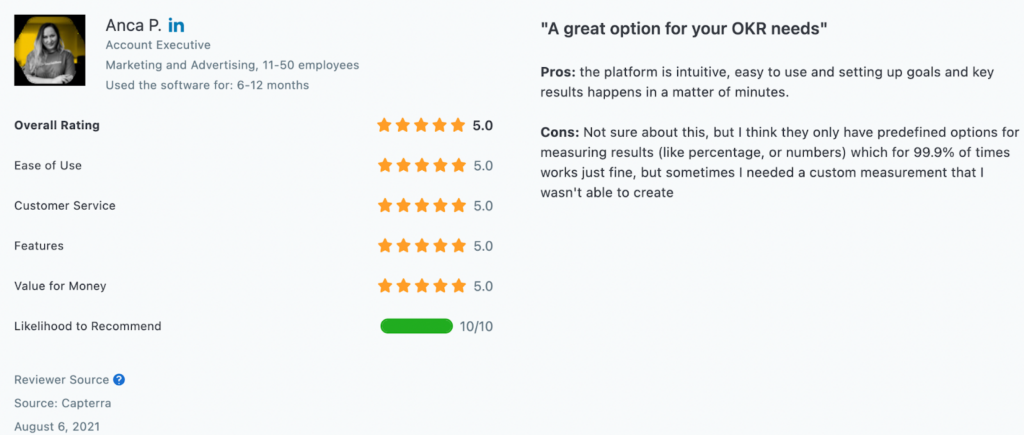
Source: Capterra
Integration: Peoplebox.ai can be integrated with over 100+50 third-party tools like JIRA, Google Sheets, Outlook, Slack, MS Teams, and more.
Deep integration with Slack and MS Team: Easily take surveys, update goals & submit performance reviews directly from Slack. Set up nudges & reminders for surveys, OKR-check-ins, and 1:1s.
Highly customizable: With Peoplebox, you can easily create customizable and presentable dashboards featuring charts, key performance indicators (KPIs), and narration. The software automatically populates the dashboard with updates on OKR (Objectives and Key Results) progress and delta.
Secure and compliant: Peoplebox.ai ensures user data security and compliance, ensuring that all data is handled safely and promptly.
Provide review and feedback: Maintaining oversight of multiple teams working towards various objectives and key results can be challenging. With Peoplebox.ai, you can review and give feedback to address any task-related issues.
Pros of Peoplebox.ai
Easy-to-use: G2 has rated Peoplebox as the easiest-to-use OKR (Objectives and Key Results) and Performance Management software. It’s one of the 50 top collaboration and productivity tools.
Better decision-making: With real-time data and insights, companies can make informed decisions about allocating resources and making strategic investments.
Cost-effective: Peoplebox.ai can help reduce costs for organizations by automating various tasks, eliminating the need for expensive software, or hiring additional staff to handle these tasks.
Scalable: Peoplebox.ai can easily scale with an organization’s needs, making it suitable for small and large businesses.
Cons of Peoplebox.ai
Limited language support: Currently, Peoplebox only supports English and this can be a drawback for non-English speaking people.
Features can be overwhelming: Feature options in OKR and the Business Review module may be overwhelming for new users.
OKR Software – Rated 4.8 on G2
Empower your managers to be a better leader with essential performance tools & personalized coaching support.
2. Profit.co
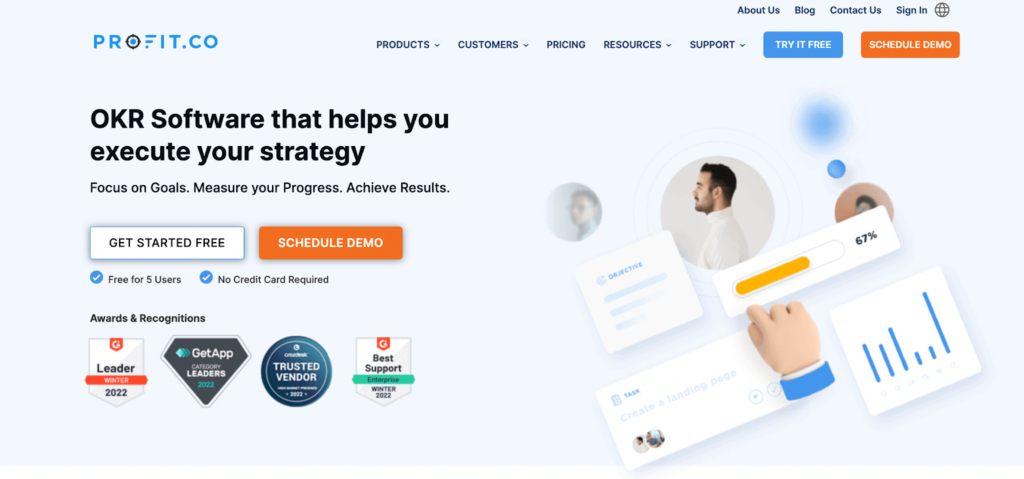
Profit.co is a project management and business productivity tool that helps organizations improve performance and achieve their goals. It features project planning, task management, resource allocation, collaboration tools, and analytics and reporting capabilities.
It is designed to help teams work more efficiently and effectively by streamlining processes and improving communication and collaboration. Profit.co can be used by small businesses, startups, and large enterprises to improve project management and drive business growth.
Notable Features of Profit.co
Goal tracking: Profit.co allows users to set and track goals for their team, including financial targets and key performance indicators (KPIs).
Performance management: The platform includes tools for tracking employee performance and providing feedback, including 360-degree reviews and goal alignment.
Collaboration and communication: Profit.co includes features for team collaboration, such as project management and document sharing, as well as communication tools like team chat and video conferencing.
Data analysis and reporting: The platform offers a range of analytics and reporting tools to help users track and analyze their performance and progress toward goals.
Customization and integrations: Profit.co allows users to customize their workspace and integrate with other tools and systems, such as CRM software and project management platforms.
Pros of Profit.co
Improved financial performance: Profit.co helps businesses track their financial performance and identify areas where they can improve profitability.
Increased efficiency: Profit.co helps businesses streamline their operations and identify areas where they can reduce waste and increase efficiency.
Enhanced collaboration: Profit.co provides a centralized platform for teams to share data and collaborate on projects, improving communication and productivity.
Enhanced customer experience: By tracking key performance indicators, businesses can identify areas where they can improve the customer experience and increase customer satisfaction.
Cons of Profit.co
Cost: Profit.co is not a free tool, and it has several pricing plans that may not fit everyone’s budget.
Complexity: The tool has many features and functions that may not be intuitive to use, especially for those unfamiliar with project management software.
Integration issues: Profit.co may not integrate with all the tools and systems that you are using in your business, which could be frustrating if you need to switch between multiple applications to manage your projects.
Limited customization: While Profit.co allows you to customize certain aspects of your projects, it may not offer the level of flexibility that you need to tailor your workflow fully.
Lack of customer support: Some users have reported that the customer support team at Profit.co is not very responsive or helpful, which can be frustrating if you have questions or need assistance.
3. Asana
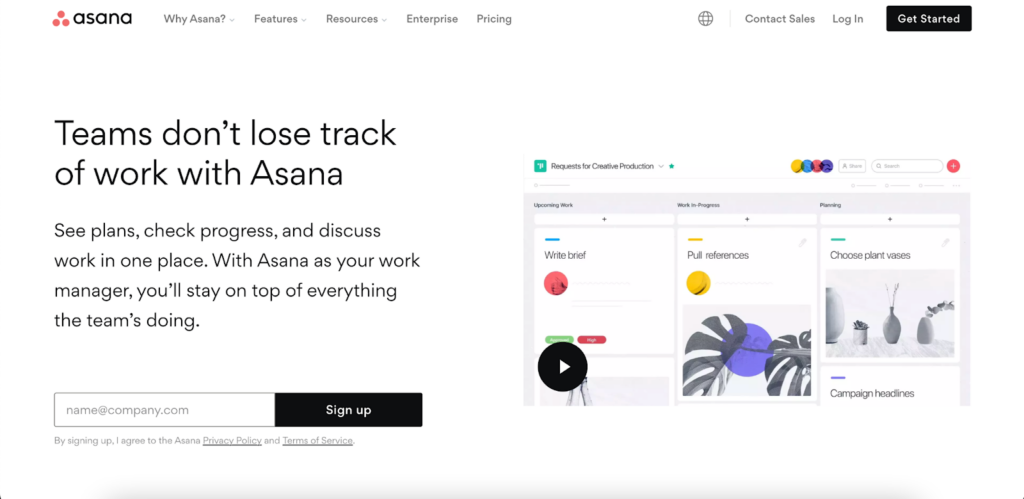
Asana is a project management and team collaboration software that helps teams organize, track, and manage their work. It provides tasks and project management tools, team communication, and document sharing.
Asana is designed to help teams work together more efficiently and effectively by providing a central platform for organizing and tracking progress on projects, tasks, and goals. It is widely used by businesses, non-profits, and other organizations to improve team productivity and collaboration.
Notable features of Asana
Customization: Asana allows users to customize their workspace with different views, boards, and tags to help organize their work and prioritize tasks.
Integrations: Asana integrates with various other tools and platforms, including Google Drive, Slack, Trello, and Salesforce, to streamline workflows and improve productivity.
Mobile app: Asana offers a mobile app for iOS and Android devices, allowing users to access and manage their tasks and projects.
Reporting and analytics: Asana provides detailed reports and analytics on project progress, team performance, and task completion rates.
Security: Asana follows strict security protocols, including data encryption and secure servers, to protect user data and ensure the privacy of user information.
Customer support: Asana offers a variety of resources and support options, including a help center, tutorials, and live training sessions, to assist users in using the platform effectively.
Pros of Asana
Customization and integration options: Asana offers a range of customization options and integrations with other tools and platforms, allowing users to tailor the tool to their specific needs and workflows.
User-friendly interface: Asana has a simple and intuitive interface, which makes it easy for users to quickly get up to speed and start using the tool effectively.
Mobile accessibility: Asana can be accessed on mobile devices, allowing users to stay connected and productive even when they are away from their desks.
Cons of Asana
Lack of integration with other tools: Asana does not integrate with many other project management tools and software, which can be a hindrance if you use multiple tools for your team.
Limited customization options: Asana’s customization options are limited, which means that you cannot fully customize the tool to fit your specific needs and workflow.
Complexity: Asana can be complex to use, especially for those who are new to project management tools. It can take some time to get used to the interface and its features.
Limited reporting and analytics: Asana’s reporting and analytics capabilities are limited compared to other project management tools. This can make it difficult to track progress and measure the effectiveness of your projects.
Limited third-party integrations: Asana does not have many third-party integrations available, which can limit the functionality of the tool.
Limited mobile app functionality: The mobile app version of Asana is not as robust as the desktop version, and many features are not available on mobile. This can be inconvenient for teams who rely on mobile apps.
4. Weekdone
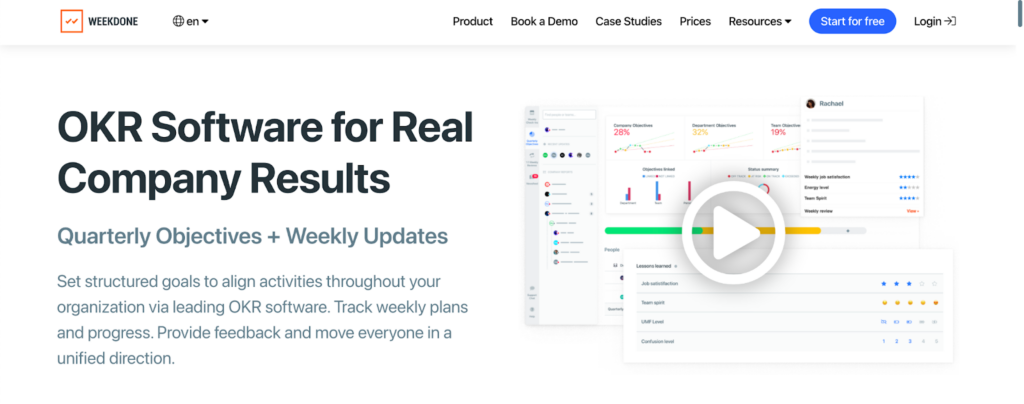
Weekdone is a tool designed for business leaders and teams to establish organized objectives, monitor progress, and unify all efforts toward the company’s vision. It helps to establish focus and achieve tangible results. As an innovative market leader since 2013, Weekdone has gained the trust and loyalty of thousands of customers.
Notable features of Weekdone
Automated reports: Stay informed about the performance of your company with interactive dashboards displaying OKR progress, receive automated email reports, and easily export custom reports with just a few clicks.
Onboarding assistance: Achieve success with your OKRs through expert assistance. Weekdone’s OKR experts offer onboarding support and coaching sessions, tailored to your company and teams, upon request.
Effective collaboration: Improve communication, coordination, and engagement within your team by ensuring everyone is on the same page. Set weekly expectations, monitor the progress of each team, and understand their overall performance.
Pros of Weekdone
Setting structured goals: Weekdone allows teams to set clear and measurable objectives, keeping everyone focused and aligned.
Tracking progress: The tool enables teams to monitor progress and stay on top of deadlines, ensuring that projects are completed on time.
Enhancing communication: Weekdone helps teams to communicate more effectively, with features such as weekly check-ins and progress reports that keep everyone informed and engaged.
Cons of Weekdone
Cost: Depending on the size and needs of your organization, the cost of a Weekdone subscription may be a significant expense.
Limited customization options: While Weekdone offers a wide range of features, some users may find that the platform doesn’t fully meet their specific needs or allows limited customization options.
Learning curve: The platform may take some time for new users to fully understand and utilize all the features, especially for those not familiar with OKR also workdone alternatives.
Given how awesome these alternatives are, you might want to consider the possible reasons why they were introduced to you in the first place. Let’s get to know Workboard, its pros and cons, and more below.
What is Workboard?
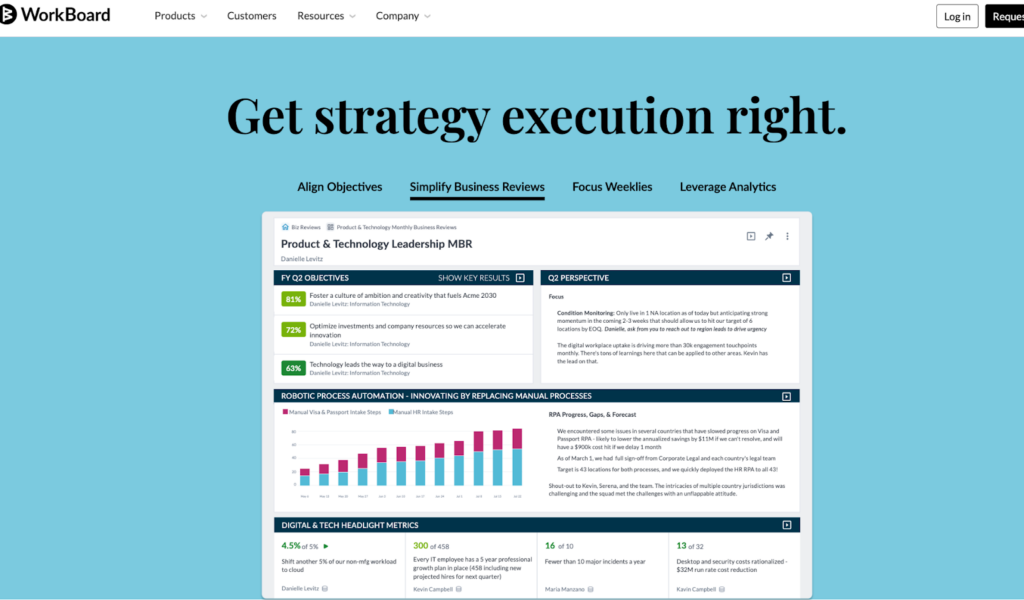
Workboard is a cloud-based OKR management platform that allows managers and their teams to set and track goals, document work for performance reviews, and report on progress. Users can also improve engagement and productivity for individual team members by setting clear goals, providing real-time feedback and rewards, and creating lists of achievements for evaluations.
Pros of Workboard
Meetings and Collaborations
The collaboration feature allows team members to communicate on different projects, share files, and share feedback on improving the outcome of each task. It also schedules and organizes meetings, making it easy to coordinate with team members and ensure that everyone is available. The platform also allows for video conferencing, which can be helpful for remote teams or those working in different locations.
Project Management
With Workboard, you can create and assign tasks to team members, set deadlines, and track progress. Gantt charts allow you to visually see the timeline of a project and identify any potential bottlenecks or delays. Calendars allow you to schedule meetings, deadlines, and events related to the project.
One-click Functionality
Workboard helps streamline communication and ensure that all team members have access to the latest information. It also eliminates the need for manual sharing of documents and helps to save time and effort. With one-click functionality, team members can easily stay informed and on track with their work, resulting in increased productivity and efficiency.
Chat and Support
Workboard comes with a chatbot, a valuable tool for streamlining communication and keeping users connected to their work. Whether you need to ask a question, check your calendar, or get a project update, the chatbot is there to help.
Cons of Workboard
Limited Customization Options
Workboard may not offer as many customization options as other project management tools, which can limit the ability to tailor the tool to specific needs and preferences.
Bad UI
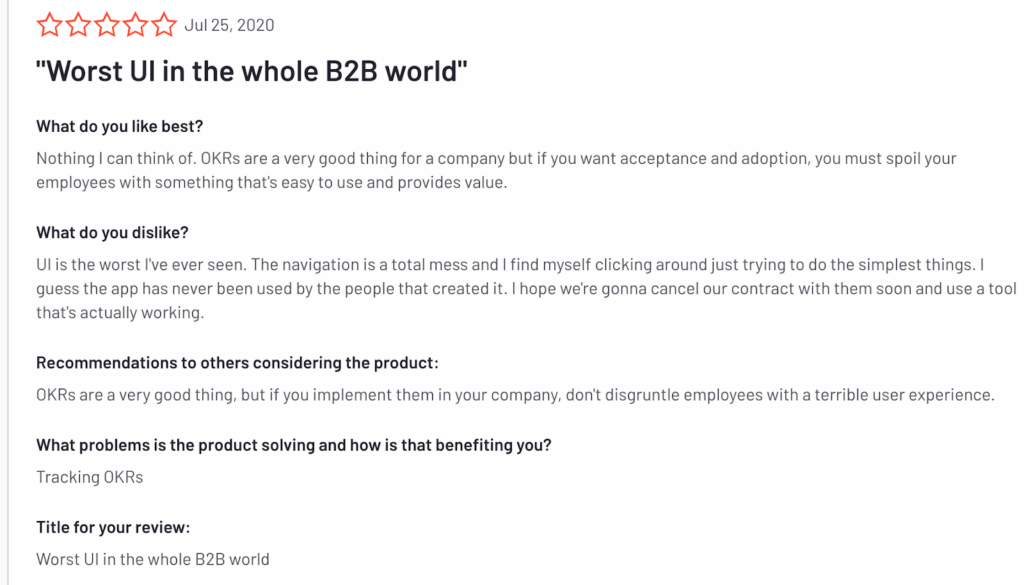
Workboard’s UI isn’t very good. It’s complex and has a difficult navigation process. Most users find it difficult to do even simple tasks.
Fewer Integration Options
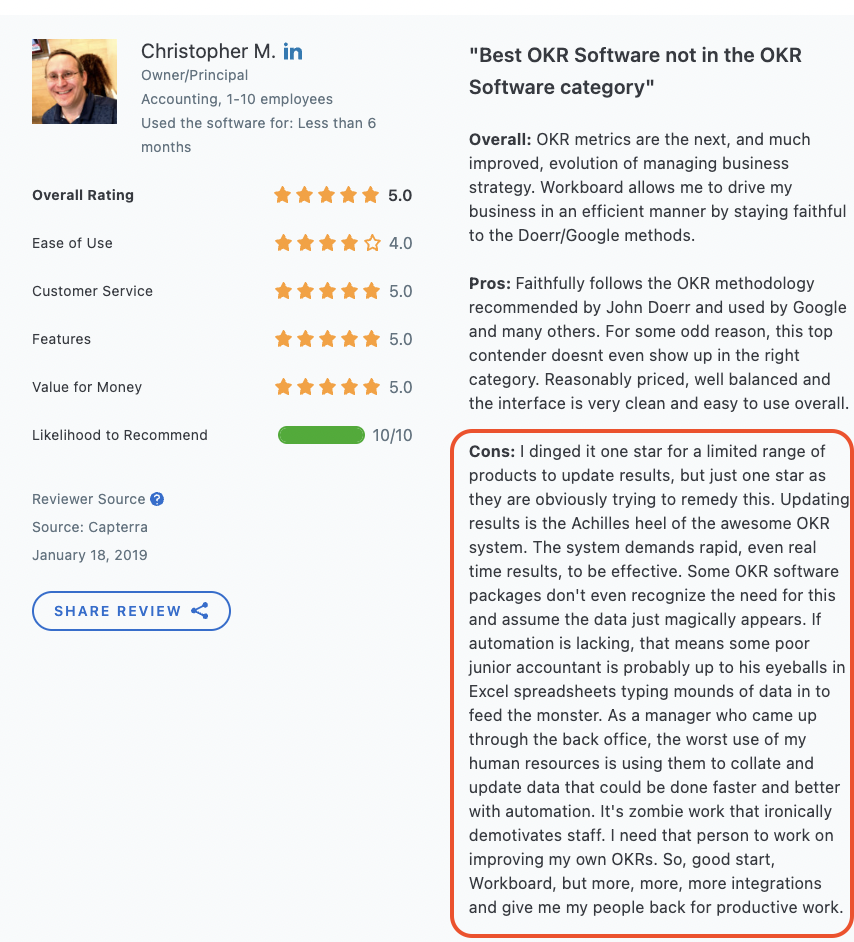
Source: Capterra
Workboard may not integrate with as many other tools and platforms as other project management software, which can make it more difficult to manage tasks and communicate with team members across multiple platforms.
Limited Reporting and Analytics Capabilities
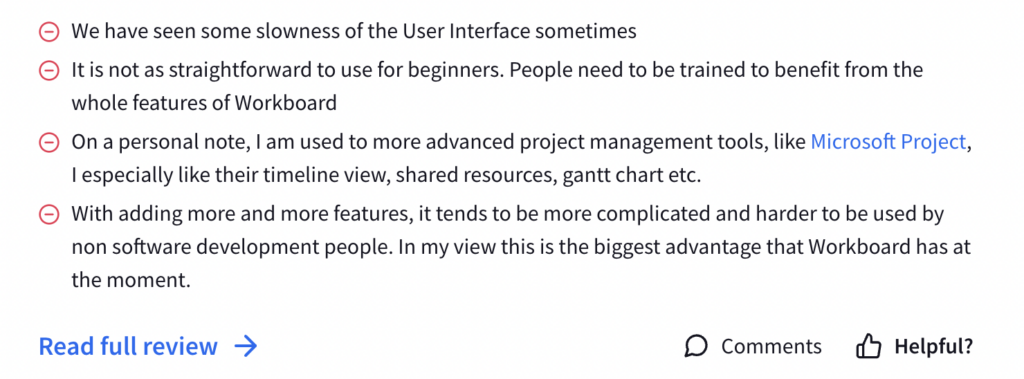
Source: Trustradius
Workboard may not offer as robust reporting and analytics capabilities as other project management tools, making it more difficult to track progress and identify areas for improvement.
Limited Scalability
Workboard may not be as scalable as other project management tools, making it more challenging for organizations with larger teams or more complex projects to use the tool effectively.
Limited Customer Support
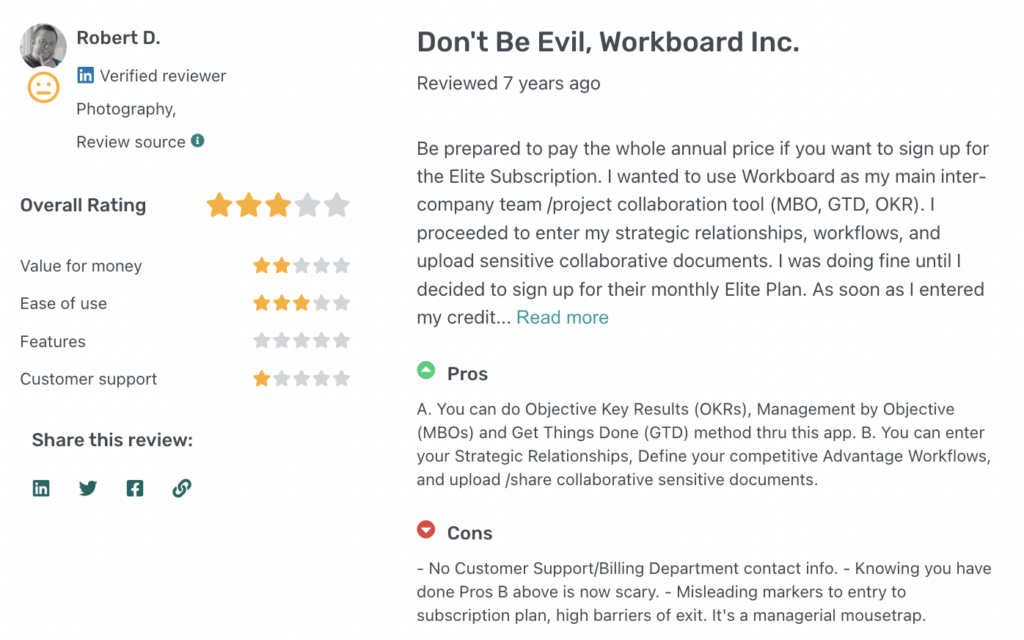
Source: GetApp
Workboard may not offer as comprehensive customer support as other project management tools, which can make it more difficult to resolve issues or get help when needed.
Final Words
If you want to implement an OKR strategy successfully, it’s essential to have the right tool. However, finding the right tools isn’t easy. You’ll need to try all the tools available and then you can choose. This is why we have created this list.
These are the best Workboard alternatives available in the market. Just find the one that suits you and your requirements the best. Once you get the right tool by your side, managing your OKR strategy would become a breeze.


